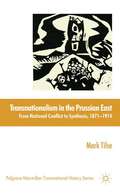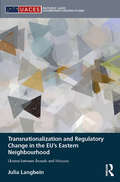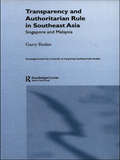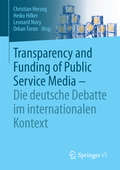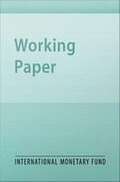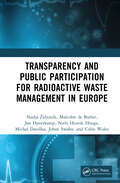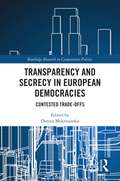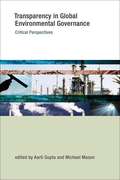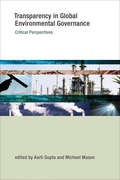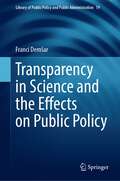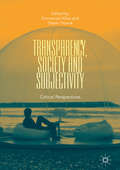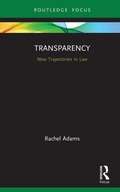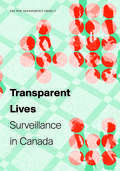- Table View
- List View
Transnationalism in the Prussian East
by Mark TilseFor more than a century following the Partitions of Poland, a protracted and often bitter national conflict pervaded life in Prussia's eastern border provinces. This book radically interprets the German Polish relationship in the Prussian East according to a theory of 'synthesis' between nations, as the first study to apply this concept in the research of nationalism. Contradiction and conflict between the nations gave rise to mentalities and practices that were 'transnational' and that harmonized the national divide. Transnationalism in the Prussian East examines the nature of this process and its profound social and political consequences, exploring in detail issues of language and semantics, sex and marriage, politics, and culture. "
Transnationalism, Activism, Art
by Kit Dobson Aine McglynnBanksy is known worldwide for his politically subversive works of art, but he is far from the only artist whose creations are infused with internationally relevant, activist themes. How else can the arts help activate citizen participation in social justice movements? Moreover, what is the role of culture in a globalizing world?Transnationalism, Activism, Art goes beyond Banksy by investigating how the three complementary political, social, and cultural phenomena listed in the title interact in the twenty-first century. Renowned and emerging critics use current theory on cultural production and politics to illuminate case studies of various media, including film, literature, visual art, and performance, in their multiple manifestations, from electronic dance music to Wikileaks to bestselling poetry collections. By addressing how these artistic media are used to enact citizen participation in social justice movements, the volume makes important connections between such participation and scholarly study of globalization and transnationalism.
Transnationalism, Nationalism and Australian History
by Alecia Simmonds Anna Clark Anne ReesUsing Australian history as a case study, this collection explores the ways national identities still resonate in historical scholarship and reexamines key moments in Australian history through a transnational lens, raising important questions about the unique context of Australia's national narrative. The book examines the tension between national and transnational perspectives, attempting to internationalize the often parochial nation-based narratives that characterize national history. Moving from the local and personal to the global, encompassing comparative and international research and drawing on the experiences of researchers working across nations and communities, this collection brings together diverging national and transnational approaches and asks several critical research questions: What is transnational history? How do new transnational readings of the past challenge conventional national narratives and approaches? What are implications of transnational and international approaches on Australian history? What possibilities do they bring to the discipline? What are their limitations? And finally, how do we understand the nation in this transnational moment?
Transnationalization and Regulatory Change in the EU's Eastern Neighbourhood: Ukraine between Brussels and Moscow (Routledge/UACES Contemporary European Studies)
by Julia LangbeinRegulatory reforms in the EU’s Eastern neighbourhood countries are not as sluggish as often perceived. Rule enforcement is happening despite the presence of domestic veto players who favour the status quo, the lack of EU membership perspective and the presence of Russia as an alternative governance provider. Using Ukraine as a primary case study, this book examines why convergence with transnational market rules varies across different policy sectors within the Eastern neighbourhood countries. It analyzes the drivers of regulatory change and explores the conditions under which post-Soviet economies integrate with international markets. In doing so, it argues that the impetus for regulatory change in the Eastern neighbourhood lies in specific strategies of domestic empowerment applied by external actors. Furthermore, through the study of the impact of Western and Russian transnational actors, the book concludes that Russia’s presence does not necessarily hinder the integration of the EU’s Eastern neighbours with international markets. Instead, Russia both weakens and strengthens domestic support for convergence with transnational market rules in the region. This book will be of key interest to students and scholars of European/EU studies and international relations, especially in the areas of regulatory politics, transnational governance, public policy, and post-Soviet transitions.
Transpacific Rebalancing
by Barry P. Bosworth Masahiro KawaiPersistently large external imbalances in the world economy contributed to the outbreak of the recent financial crisis. The current account imbalances were particularly severe among the economies that border on the Pacific--the United States ran large deficits, with offsetting surpluses in East Asia. The depth and breadth of the global recession also demonstrated the need for a coordination of national policies to achieve a sustained recovery.While the magnitude of global-trade disruption led to some reduction in the size of the imbalances, closer examination suggests that the progress may prove temporary. On the other hand, significant changes in the underlying patterns of saving and investment suggest that some of the recent rebalancing may prove to be more permanent. Are such imbalances really a problem? If so, why and for whom? What should be done about them--if anything--and what does the future likely hold for transpacific trade relations? In this timely book, Asian and American economists explore those important questions.Copublished with the Asian Development Bank Institute, Transpacific Rebalancing is coedited by Barry Bosworth--long one of the Brookings Institution's leading economic analysts--and Masahiro Kawai, dean of the ADBI. They brought together leading economists from either side of the Pacific to analyze such issues as: The impact of exchange rates The policy choices facing the "Asian tigers" The specifics and effects of trade imbalances in specific countries including the United States, South Korea, Thailand, India, and ChinaContributors include Hwee Kwan Chow, Susan M. Collins, Barry Eichengreen, Joonkyung Ha, Yping Huang, Ginalyn Komoto, Jong-Wha Lee, Rajiv Kumar, Deunden Nikomborirak, Gisela Rua, Lea Sumulong, Chalongphob Sussankam, Kunyu Tao, Willem Thorbecke, and Pankaj Vashisht.
Transpacific Rebalancing
by Barry P. Bosworth Masahiro KawaiPersistently large external imbalances in the world economy contributed to the outbreak of the recent financial crisis. The current account imbalances were particularly severe among the economies that border on the Pacific-the United States ran large deficits, with offsetting surpluses in East Asia. The depth and breadth of the global recession also demonstrated the need for a coordination of national policies to achieve a sustained recovery.While the magnitude of global-trade disruption led to some reduction in the size of the imbalances, closer examination suggests that the progress may prove temporary. On the other hand, significant changes in the underlying patterns of saving and investment suggest that some of the recent rebalancing may prove to be more permanent. Are such imbalances really a problem? If so, why and for whom? What should be done about them-if anything-and what does the future likely hold for transpacific trade relations? In this timely book, Asian and American economists explore those important questions.Copublished with the Asian Development Bank Institute, Transpacific Rebalancing is coedited by Barry Bosworth-long one of the Brookings Institution's leading economic analysts-and Masahiro Kawai, dean of the ADBI. They brought together leading economists from either side of the Pacific to analyze such issues as: The impact of exchange rates The policy choices facing the "Asian tigers" The specifics and effects of trade imbalances in specific countries including the United States, South Korea, Thailand, India, and ChinaContributors include Hwee Kwan Chow, Susan M. Collins, Barry Eichengreen, Joonkyung Ha, Yping Huang, Ginalyn Komoto, Jong-Wha Lee, Rajiv Kumar, Deunden Nikomborirak, Gisela Rua, Lea Sumulong, Chalongphob Sussankam, Kunyu Tao, Willem Thorbecke, and Pankaj Vashisht.
Transparency and American Primacy in World Politics
by James J. MarquardtAt a time when greater transparency is needed, this book advances a novel explanation of America's efforts to advance greater transparency in international relations. Marquardt argues that American statesmen have long sought to secure an American-dominated international system to encourage states to be more open and forthcoming about their internal affairs. Yet the United States routinely uses its calls for military transparency in particular as a policy instrument to discipline its rivals and therefore paradoxically contributes to greater tension in international relations. In contrast to conventional thinking about transparency in relation to overcoming power politics and promoting international cooperation, this book explores the relationship between America's power and international security competition. Though analytically distinct, openness and transparency have served the same strategic goal; ensuring America's position of preponderance in the international system.
Transparency and Authoritarian Rule in Southeast Asia: Singapore and Malaysia (Routledge/City University of Hong Kong Southeast Asia Series)
by Garry RodanIn Transparency and Authoritarian Rule in Southeast Asia, Rodan rejects the notion that the 1997-98 Asian economic crisis was further evidence that ultimately capitalism can only develop within liberal social and political institutions, and that new technology necessarily undermines authoritarian control. Instead, Rodan argues that in Singapore and Malaysia external pressures for transparency reform were, and are, in many respects, being met without serious compromise to authoritarian rule or the sanctioning of media freedom.
Transparency and Funding of Public Service Media – Die deutsche Debatte im internationalen Kontext
by Leonard Novy Christian Herzog Heiko Hilker Orkan TorunDurch ihren #65533;ffentlichen Auftrag und die Finanzierung durch die Haushaltsabgabe stehen ARD, ZDF und das Deutschlandradio unter einem besonderen Legitimations- und Rechtfertigungsdruck. Dabei r#65533;cken Forderungen nach transparenteren Finanz- und Gremienstrukturen der Sendeanstalten zunehmend in den Vordergrund. Neben der deutschen Debatte reflektiert der Band in 14 L#65533;nderfallstudien Entwicklungen und Diskussionen um die Zukunft der Finanzierung #65533;ffentlich-rechtlicher Medien und verbindet dabei medienpolitische Forschung und Praxis.
Transparency and Monetary Policy with Imperfect Common Knowledge
by Mauro RocaA report from the International Monetary Fund.
Transparency and Public Participation for Radioactive Waste Management in Europe
by Nadja Železnik Jan Haverkamp Niels Henrik Hooge Michal Daniška Johan Swahn Colin Wales Malcolm de ButlerTransparency and Public Participation for Radioactive Waste Management in Europe investigates how the pillars of the Aarhus Convention, and a broader understanding of transparency by Civil Society (CS), can be transposed into Radioactive Waste Management (RWM), particularly in the establishment of Radioactive Waste (RW) facilities in different national contexts.With an analysis of nine national cases from Europe, the book provides the results of the investigations, including comments, suggestions, questions, and other observations, collected in interaction with other EURAD-1 participants from civil society. It discusses the feedback provided within a questionnaire completed by ROUTES members for the development of national programmes on radioactive waste management submitted to the waste directive, based on effective access to information, public participation, justice, resources, and transparency.The book will interest nuclear energy policymakers, government employees, and radioactive waste management facility operators. It will also aid researchers and academics investigating public perception and facility siting considerations.
Transparency and Secrecy in European Democracies: Contested Trade-offs (Routledge Research in Comparative Politics)
by Dorota MokrosinskaThis edited volume offers a critical discussion of the trade-offs between transparency and secrecy in the actual political practice of democratic states in Europe. As such, it answers to a growing need to systematically analyse the problem of secrecy in governance in this political and geographical context. Focusing on topical cases and controversies in particular areas, the contributors reflect on the justification and limits of the use of secrecy in democratic governance, register the social, cultural, and historical factors that inform this process and explore the criteria used by European legislators and policy-makers, both at the national and supranational level, when balancing interests on the sides of transparency and secrecy, respectively. This book will be of key interest to scholars and students of security studies, political science, European politics/studies, law, history, political philosophy, public administration, intelligence studies, media and communication studies, and information technology sciences.
Transparency and Surveillance as Sociotechnical Accountability: A House of Mirrors (Routledge Studies in Science, Technology and Society #28)
by Deborah G. Johnson Priscilla M. ReganSurveillance and transparency are both significant and increasingly pervasive activities in neoliberal societies. Surveillance is taken up as a means to achieving security and efficiency; transparency is seen as a mechanism for ensuring compliance or promoting informed consumerism and informed citizenship. Indeed, transparency is often seen as the antidote to the threats and fears of surveillance. This book adopts a novel approach in examining surveillance practices and transparency practices together as parallel systems of accountability. It presents the house of mirrors as a new framework for understanding surveillance and transparency practices instrumented with information technology. The volume centers around five case studies: Campaign Finance Disclosure, Secure Flight, American Red Cross, Google, and Facebook. A series of themed chapters draw on the material and provide cross-case analysis. The volume ends with a chapter on policy implications.
Transparency and the Open Society: Practical Lessons for Effective Policy
by Roger Taylor Tim KelseyGreater transparency is increasingly seen as the answer to a wide range of social issues by governments, NGOs and businesses around the world. However, evidence of its impact is mixed. Using case studies from around the world including India, Tanzania, the UK and US, Transparency and the open society surveys the adoption of transparency globally, providing an essential framework for assessing its likely performance as a policy and the steps that can be taken to make it more effective. It addresses the role of transparency in the context of growing use by governments and businesses of surveillance and database driven decision making. The book is written for anyone involved in the use of transparency whether campaigning from outside or working inside government or business to develop policies.
Transparency in Global Environmental Governance
by Michael Mason Aarti GuptaTransparency -- openness, secured through greater availability of information -- isincreasingly seen as part of the solution to a complex array of economic, political, and ethicalproblems in an interconnected world. The "transparency turn" in global environmentalgovernance in particular is seen in a range of international agreements, voluntary disclosureinitiatives, and public-private partnerships. This is the first book to investigate whethertransparency in global environmental governance is in fact a broadly transformative force or plays amore limited, instrumental role. After three conceptual, context-setting chapters,the book examines ten specific and diverse instances of "governance by disclosure. " Theseinclude state-led mandatory disclosure initiatives that rely on such tools as prior informed consentand monitoring, measuring, reporting and verification; and private (or private-public), largelyvoluntary efforts that include such corporate transparency initiatives as the Carbon DisclosureProject and such certification schemes as the Forest Stewardship Council. The cases, which focus onissue areas including climate change, biodiversity, biotechnology, natural resource exploitation,and chemicals, demonstrate that although transparency is ubiquitous, its effects are limited andoften specific to particular contexts. The book explores in what circumstances transparency canoffer the possibility of a new emancipatory politics in global environmental governance.
Transparency in Global Environmental Governance: Critical Perspectives (Earth System Governance)
by Michael Mason Aarti GuptaA critical assessment of whether transparency is a broadly transformative force in global environmental governance or plays a more limited role.Transparency—openness, secured through greater availability of information—is increasingly seen as part of the solution to a complex array of economic, political, and ethical problems in an interconnected world. The “transparency turn” in global environmental governance in particular is seen in a range of international agreements, voluntary disclosure initiatives, and public-private partnerships. This is the first book to investigate whether transparency in global environmental governance is in fact a broadly transformative force or plays a more limited, instrumental role.After three conceptual, context-setting chapters, the book examines ten specific and diverse instances of “governance by disclosure.” These include state-led mandatory disclosure initiatives that rely on such tools as prior informed consent and monitoring, measuring, reporting and verification; and private (or private-public), largely voluntary efforts that include such corporate transparency initiatives as the Carbon Disclosure Project and such certification schemes as the Forest Stewardship Council. The cases, which focus on issue areas including climate change, biodiversity, biotechnology, natural resource exploitation, and chemicals, demonstrate that although transparency is ubiquitous, its effects are limited and often specific to particular contexts. The book explores in what circumstances transparency can offer the possibility of a new emancipatory politics in global environmental governance.
Transparency in Government Operations
by George Kopits Jon Craig#"February 1998. "#Includes bibliographical references.
Transparency in International Law
by Anne Peters Andrea BianchiWhile its importance in domestic law has long been acknowledged, transparency has until now remained largely unexplored in international law. This study of transparency issues in key areas such as international economic law, environmental law, human rights law and humanitarian law brings together new and important insights on this pressing issue. Contributors explore the framing and content of transparency in their respective fields with regard to proceedings, institutions, law-making processes and legal culture, and a selection of cross-cutting essays completes the study by examining transparency in international law-making and adjudication.
Transparency in Science and the Effects on Public Policy (Library of Public Policy and Public Administration #19)
by Franci DemšarThis book argues that, in the development of science, three principles have been used; transparency of results; transparency of procedures; financial transparency. Though the topic of transparency has been researched from various angles by many academics, none have made a comparison between the development of science in the last 350 years and the aforementioned principles. The author uniquely explains how these elements contributed to the rapid development of science and consequently that of technology and human wellbeing and suggests legislation for ensuring transparency in the public sector. In addition, this book provides numerous examples of successful new ways of using these principles in other activities in the public sector as well as possibilities of including the transparency principles from science publishing into general and internet media.
Transparency, Power, and Influence in the Pharmaceutical Industry: Policy Gain or Confidence Game?
by Katherine Fierlbeck, Janice Graham, Matthew HerderThere is plenty of controversy surrounding pharmaceuticals, but it cannot be denied that the pharmaceutical industry is both socially beneficial and profitable. Regulators are expected to ensure that the economic success of the industry does not come at the expense of public safety, yet they have also assumed a cooperative role by providing advice on regulation and by targeting unmet medical needs. Concerns over regulatory standards, conflicts of interest, and the manipulation of information on drug safety and effectiveness have led to public mistrust and a greater need for transparency between the pharmaceutical industry and government regulators. Transparency, Power, and Influence in the Pharmaceutical Industry evaluates the progress made in holding the pharmaceutical industry responsible for creating transparency in the industry, from development to market. The contributors to this volume examine the various mechanisms introduced to make the regulatory process more informative and situate these efforts within the larger project of enhancing the safety of drugs, vaccines, and other products.
Transparency, Society and Subjectivity: Critical Perspectives
by Emmanuel Alloa Dieter ThomäThis book critically engages with the idea of transparency whose ubiquitous demand stands in stark contrast to its lack of conceptual clarity. The book carefully examines this notion in its own right, traces its emergence in Early Modernity and analyzes its omnipresence in contemporary rhetoric. Today, transparency has become a catchword outplaying other Enlightenment values like empowerment, sincerity and the notion of a public sphere. In a suspicious manner, transparency is entangled in the discourses on power, surveillance, and self-exposure. Bringing together prominent scholars from the emerging field of Critical Transparency Studies, the book offers a map of the various sites at which transparency has become virulent and connects the dots between past and present. By studying its appearances in today’s hyper-mediated economies of information and by linking it back to its historical roots, the book analyzes transparency and its discontents, and scrutinizes the reasons why it has become the imperative of a supposedly post-ideological age.
Transparency: New Trajectories in Law (New Trajectories in Law)
by Rachel AdamsThis book critiques the contemporary recourse to transparency in law and policy. This is, ostensibly, the information age. At the heart of the societal shift toward digitalisation is the call for transparency and the liberalisation of information and data. Yet, with the recent rise of concerns such as 'fake news', post-truth and misinformation, where the policy responses to all these phenomena has been a petition for even greater transparency, it becomes imperative to critically reflect on what this dominant idea means, whom it serves, and what the effects are of its power. In response, this book provides the first sustained critique of the concept of transparency in law and policy. It offers a concise overview of transparency in law and policy around the world, and critiques how this concept works discursively to delimit other forms of governance, other ways of knowing and other realities. It draws on the work of Michel Foucault on discourse, archaeology and genealogy, together with later Foucaultian scholars, including Gayatri Chakravorty Spivak and Judith Butler, as a theoretical framework for challenging and thinking anew the history and understanding of what has become one of the most popular buzzwords of 21st century law and governance. At the intersection of law and governance, this book will be of considerable interest to those working in these fields; but also to those engaged in other interdisciplinary areas, including society and technology, the digital humanities, technology laws and policy, global law and policy, as well as the surveillance society.
Transparent Government
by Donald GordonProvides a blueprint for more effective government and greater citizen participation."Transparency" has become the new mantra of politicians and pundits alike. But what does it mean in practice? In this informative, clearly written book community activist Donald Gordon defines the essential features of a transparent government and makes a convincing case that it is critical for a healthy and maturing democracy and the basic liberties we all take for granted.Gordon first presents a clear definition of transparency in government and why we should pursue it, followed by a review of the history of transparency in American politics. He then makes the case for how transparency serves as the foundation for active civic engagement. The heart of the book is Gordon's "Transparency Index." The author examines best practices in measuring transparency and then isolates the critical factors that can be used to assess any type of government and its commitment to transparency. In addition, a scoring system is presented that allows for comparison of government entities.For anyone who wishes that government were more effective and responsive, this book shows how these goals can be achieved.
Transparent Lives: Surveillance in Canada
by David Lyon Valerie Steeves Kevin D. Haggerty Colin J. Bennett"Although most Canadians are familiar with surveillance cameras and airport security, relatively few are aware of the extent to which the potential for surveillance is now embedded in virtually every aspect of our lives. We cannot walk down a city street, register for a class, pay with a credit card, hop on an airplane, or make a telephone call without data being captured and processed. Where does such information go? Who makes use of it, and for what purpose? Is the loss of control over our personal information merely the price we pay for using social media and other forms of electronic communication, or should we be wary of systems that make us visible—and thus vulnerable—to others as never before? The work of a multidisciplinary research team, Transparent Lives explains why and how surveillance is expanding—mostly unchecked—into every facet of our lives. Through an investigation of the major ways in which both government and private sector organizations gather, monitor, analyze, and share information about ordinary citizens, the volume identifies nine key trends in the processing of personal data that together raise urgent questions of privacy and social justice. Intended not only to inform but to make a difference, the volume is deliberately aimed at a broad audience, including legislators and policymakers, journalists, civil liberties groups, educators, and, above all, the reading public."
Transparent Lobbying and Democracy
by Šárka Laboutková Vít Šimral Petr Vymětal"The authors come up with some innovative tools, namely the “Catalogue of transparent lobbying”. They look at and evaluate the impact on both key stakeholders (lobbyists and targets of lobbying), monitoring of lobbying activities and sanctioning for breaches of rules. This tool holds out benchmarking capacity of sound framework for understanding of lobbying in the context of democracy, legitimacy of decision-making and accountability."David Ondráčka, member of global Board of Transparency International, head of Transparency International, Czech Republic"Transparent Lobbying and Democracy provides a comprehensive view into the phenomenon of lobbying... As a well-established scientist specializing in democracy, civil society and the public sphere, I see it as a useful and enriching contribution to the debate on lobbying, its necessary transparency and its role in the democratization process. This book has the potential to reach an international audience of experts and interested lay persons, and both complement and compete with publications on similar issues."Karel B. Müller, University of Economics in Prague, Czech RepublicThis book deals with the current, as yet unsolved, problem of transparency of lobbying. In the current theories and prevalent models that deal with lobbying activities, there is no reflection of the degree of transparency of lobbying, mainly due to the unclear distinction between corruption, lobbying in general, and transparent lobbying. This book provides a perspective on transparency in lobbying in a comprehensive and structured manner. It delivers an interdisciplinary approach to the topic and creates a methodology for assessing the transparency of lobbying, its role in the democratization process and a methodology for evaluating the main consequences of transparency. The new approach is applied to assess lobbying regulations in the countries of Central Eastern Europe and shows a method for how lobbying in other regions of the world may also be assessed.
